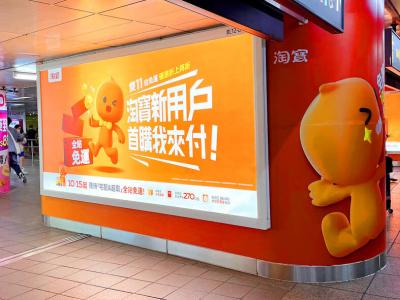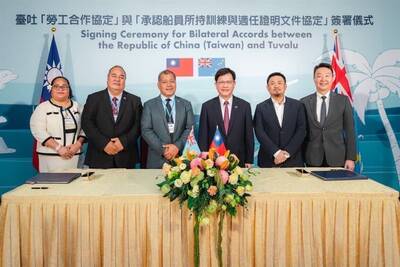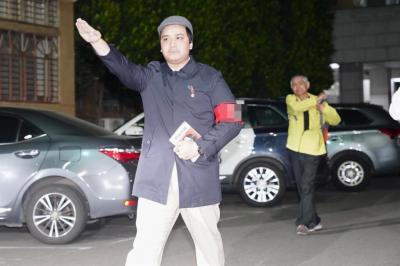Spending on technological research and development (R&D) in Taiwan last year totaled NT$660.8 billion (US$22.88 billion), with a record ratio to GDP of 3.5 percent, the Ministry of Science and Technology said on Friday, while sounding the alarm about the nation’s aging research population.
Of last year’s spending, NT$540.7 billion came from the private sector, up 8.1 percent from 2018, while NT$120.1 billion came from the government, up 3.7 percent from 2018, ministry data showed.
The ration of tech R&D to GDP has been increasing annually, from 3 percent in 2015 to 3.5 percent last year, the data showed.
Private-sector R&D has focused on improving manufacturing processes and developing new products, while the government and educational institutions have pursued cutting-edge research and innovation, especially those related to the government’s “5 plus 2” innovative industries plan, the ministry said.
The “5 plus 2” industries are intelligent machinery, an Asian Silicon Valley, biotechnology, green energy, national defense and aerospace, innovative agriculture and the circular economy.
Of the total spending, 70.3 percent (NT$464.7 billion) was spent on technical development, followed by 22.7 percent (NT$150 billion) on applied research and 7 percent (NT$46.1 billion) on basic research, the data showed.
Spending on basic research has risen compared with 2018 (NT$44.9 billion), but declined compared with 2017 (NT$46.6 billion), 2016 (NT$46.8 billion) and 2015 (NT$47.2 billion), the data showed.
The ministry acknowledged that the ratio of basic research to overall spending is lower than in most other countries, including those of similar scale to Taiwan.
Singapore in 2018 allocated 23.84 percent of spending on technological R&D to basic research, the ministry said, citing data from the Organisation for Economic Co-operation and Development’s Main Science and Technology Indicators.
In the same year, South Korea allocated 14.21 percent to basic research, followed by Japan at 12.57 percent and Israel at 10.41 percent, which were all higher than Taiwan’s 7.29 percent and China’s 5.54 percent, the data showed.
To increase Taiwan’s basic research capacity, the ministry, apart from seeking more funding, would draft a plan to encourage businesses to allocate more effort to the area, it said.
The ministry said that it is concerned about the rate at which the nation’s research population is aging.
Researchers aged 55 or older made up 8.8 percent of the research population last year, up from 7.1 percent in 2015, while those aged 45 to 54 made up 17.7 percent, up 16.5 percent from 2015, the data showed.
Those aged 35 to 44 made up 34.7 percent of the research population last year, down from 35.5 percent in 2017, while those aged 34 or younger made up 38.9 percent, down from 42.1 percent in 2015, the data showed.
The ministry has budgeted NT$1.8 billion next year for programs to cultivate young talent and would make a bid to balance the age groups through other means, it said.
The ministry said that the post-COVID-19 era might pose additional challenges, but the government would continue to promote the “5 plus 2” innovative industries.
It said it would also promote an additional six core strategic industries: information and digital technology, cybersecurity, biomedical technology, defense and aerospace technology, renewable energy and strategic stockpile industries.

The Ministry of Economic Affairs has fined Taobao NT$1.2 million (US$36,912) for advertisements that exceed its approved business scope, requiring the Chinese e-commerce platform to make corrections in the first half of this year or its license may be revoked. Lawmakers have called for stricter enforcement of Chinese e-commerce platforms and measures to prevent China from laundering its goods through Taiwan in response to US President Donald Trump’s heavy tariffs on China. The Legislative Yuan’s Finance Committee met today to discuss policies to prevent China from dumping goods in Taiwan, inviting government agencies to report. Democratic Progressive Party Legislator Kuo Kuo-wen (郭國文) said

The Ministry of Economic Affairs has fined Taobao NT$1.2 million (US$36,900) for advertisements that exceeded its approved business scope and ordered the Chinese e-commerce platform to make corrections in the first half of this year or its license would be revoked. Lawmakers have called for stricter supervision of Chinese e-commerce platforms and more stringent measures to prevent China from laundering its goods through Taiwan as US President Donald Trump’s administration cracks down on origin laundering. The legislature’s Finance Committee yesterday met to discuss policies to prevent China from dumping goods in Taiwan, inviting government agencies to report on the matter. Democratic Progressive Party

Taiwan and its Pacific ally Tuvalu on Tuesday signed two accords aimed at facilitating bilateral cooperation on labor affairs, according to Taiwan’s Ministry of Foreign Affairs (MOFA). The governments inked two agreements in Taipei, witnessed by Foreign Minister Lin Chia-lung (林佳龍) and visiting Deputy Tuvaluan Prime Minister Panapasi Nelesone, MOFA said in a news release. According to MOFA, the agreements will facilitate cooperation on labor issues and allow the two sides to mutually recognize seafarers’ certificates and related training. Taiwan would also continue to collaborate with Tuvalu across various fields to promote economic prosperity as well as the well-being of their

Sung Chien-liang (宋建樑), who led efforts to recall Democratic Progressive Party (DPP) Legislator Lee Kun-cheng (李坤城), was released on bail of NT$80,000 today amid outcry over his decision to wear a Nazi armband to questioning the night before. Sung arrived at the New Taipei District Prosecutors’ Office for questioning in a recall petition forgery case last night wearing a red armband bearing a swastika, carrying a copy of Adolf Hitler’s Mein Kampf and giving a Nazi salute. Sung left the building at 1:15am without the armband and covering the book with his coat. Lee said today that this is a serious